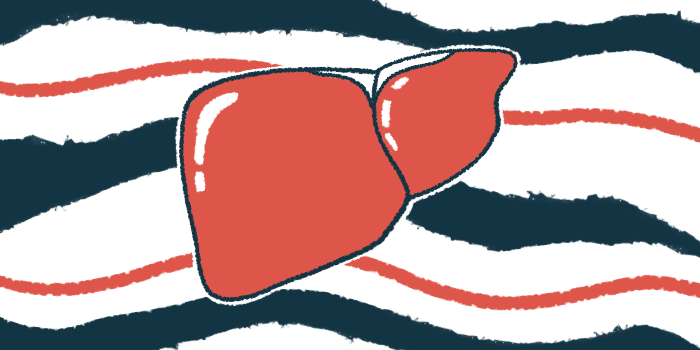Lanifibranor reduces abnormalities in liver blood vessel cells: Study
These issues found to be linked to scarring, inflammation of the organ in MASH
Written by |

Six months of treatment with lanifibranor, Inventiva’s experimental therapy, reduced abnormalities in liver sinusoidal endothelial cells (LSECs) in people with metabolic dysfunction-associated steatohepatitis (MASH), a severe type of fatty liver disease, according to a study. LSECs are a specialized type of cell that lines the blood vessels within the liver.
An analysis of liver biopsies of MASH patients who participated in the Phase 2b NATIVE clinical trial (NCT03008070) also found that these abnormalities were associated with liver scarring, known as fibrosis, and inflammation in MASH, data showed.
“These findings strengthen our confidence in lanifibranor’s potential to help prevent progression to cirrhosis [irreversible liver fibrosis] and associated clinical events,” Kris V. Kowdley, MD, director of Liver Institute Northwest in Seattle, said in a company press release.
The results were described in the study “Altered liver sinusoidal endothelial cells in MASLD and their evolution following lanifibranor treatment,” which was published in JHEP Reports.
The Phase 3 NATiV3 trial (NCT04849728) is now testing lanifibranor against a placebo in about 1,000 MASH patients with advanced liver fibrosis. Top-line data are expected in the second half of next year.
LSECs play crucial role in blood vessel changes in liver diseases
Metabolic dysfunction-associated steatotic liver disease (MASLD) is a type of fatty liver disease characterized by the accumulation of fatty deposits in the liver. It’s associated with metabolic issues, including high blood pressure, diabetes, high blood fat levels, and obesity.
MASH is a severe manifestation of MASLD marked by progressive liver inflammation, fibrosis, and, eventually, cirrhosis, which can set the stage for liver failure.
These cells have small pores called fenestrae that allow liver cells to release excess fatty molecules into the bloodstream.
Capillarization, or the loss of fenestrae in LSECs, is thought to occur early on in the MASLD liver and to contribute to MASH progression. Without sufficient fenestrae, fatty molecules are retained and accumulate within the liver.
LSECs “play a crucial role in the vascular [blood vessel] changes seen in liver diseases, including MASH and cirrhosis,” Kowdley said. “Capillarization of these cells appears early, even before the onset of MASH.”
Oral therapy designed to activate gene-regulating proteins
Lanifibranor is an experimental oral therapy designed to activate three forms of PPARs, a family of proteins that regulate genes involved in metabolic processes, inflammation, and scarring related to MASH.
NATIVE was a Phase 2b trial that tested lanifibranor in more than 200 adults with MASH. Approximately six months of once-daily lanifibranor treatment significantly reduced MASH activity and several disease-related biomarkers.
The researchers examined liver biopsies collected from people with possible MASH who were screened for the NATIVE trial to investigate LSEC capillarization and the impact of lanifibranor treatment. LSEC capillarization was measured by staining for a protein called CD34.
Of the 249 people with evaluable liver biopsy at screening, 209 had MASH, and 40 did not. Results showed those with MASH had a higher density of CD34-positive blood vessels, or more LSEC capillarization, than those without MASH.
More LSEC capillarization was also significantly associated with more liver inflammation and fibrosis, as well as several biomarkers for liver injury. Among people without MASH, there was more extensive LSEC capillarization in those with MASLD than in those without signs of the liver disease.
“Our observations thus reinforce the hypothesis that LSEC capillarisation occurs in MASLD before the development of liver fibrosis and contributes to its development,” the researchers wrote.
Lanifibranor treatment shown to reduce capillarization
The researchers also ruled out a link between CD34 staining and excess liver fat or liver cell enlargement, suggesting that “drivers for LSEC capillarisation might not be derived from [liver cells] but possibly rather from circulating cells or mediators present in portal blood in the context of metabolic syndrome,” the team wrote.
Portal blood refers to blood carried by the portal vein, which delivers blood from abdominal organs to the liver.
The results from the Phase 2b NATIVE trial with lanifibranor show a correlation between LSEC capillarization and both the stage of fibrosis and inflammation, along with evidence suggesting that lanifibranor can reduce this capillarization.
When the researchers examined liver samples from NATIVE participants, they found that six months of lanifibranor treatment reduced LSEC capillarization in a dose-dependent manner compared with the placebo.
“The results from the Phase 2b NATIVE trial with lanifibranor show a correlation between LSEC capillarization and both the stage of fibrosis and inflammation, along with evidence suggesting that lanifibranor can reduce this capillarization,” Kowdley said.
To support these findings, the team created two rat models, one of early MASLD and the other of MASH, and treated them with lanifibranor, molecules that activate individual PPARs (fenofibrate, rosiglitazone, and GW501516), or a placebo.
With the placebo, the models exhibited increased LSEC capillarization, intrahepatic vascular resistance, or resistance to blood flow in the liver’s blood vessels, and blood pressure in the portal vein. Some of these abnormalities appeared before signs of inflammation and fibrosis.
Lanifibranor normalized intrahepatic vascular resistance and portal venous pressure and reduced CD34 staining, whereas molecules that activate individual PPARs led to partial improvements.
“This study showed that LSEC capillarisation occurred in patients already at the stage of simple [excess liver fat], just as in animal models,” the researchers concluded. “LSEC capillarisation further increased with MASH, and was strongly associated with liver fibrosis and to a lesser extent inflammation, but regressed following treatment with … lanifibranor.”








